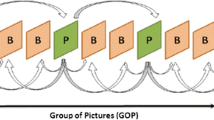Abstract
This paper proposes an adaptive cross-layer mapping algorithm to improve the transmission quality of MPEG-4 video stream over an IEEE 802.11e wireless network. Instead of classifying video data to a specific access category in an 802.11e network, we propose an algorithm that dynamically maps MPEG-4 video packets to appropriate access categories according to both the significance of the video data and the network traffic load. Our proposed cross-layer architecture passes information about the significance of video packets from the application layer to the media access control layer. The queue length of a specific access category is used to deduce the network traffic load. We conducted a performance evaluation of our proposed cross-layer approach under both light and heavily loaded network conditions. Our simulation results demonstrate: (a) superior performance of our proposed approach (under both light and heavy loads) over 802.11e (Enhanced Distributed Channel Access (EDCA) and static mapping schemes, (b) not only guarantees prioritized transmission of essential video data but also provides efficient queue length utilization.
Similar content being viewed by others
References
IEEE Std 802.11e-2005 (2005). Wireless LAN medium access control (MAC) and physical layer (PHY) specifications amendment 8: medium access control (MAC) quality of service enhancements.
Takeuchi, S., Sezaki, K., & Yasuda, Y. (2005). Dynamic adaptation of contention window sizes in IEEE 802.11e wireless LAN. In Fifth international conference on information, communications and signal processing (ICICSP 2005) (pp. 659–663).
Wang, Y., & Huang, B. (2004). Performance improvement of IEEE 802.11e. In The 13th IEEE workshop on local and metropolitan area networks, LANMAN 2004 (pp. 51–54), 25–28 April 2004.
Majkowski, J., & Palacio, F. C. (2006). Enhanced TXOP scheme for efficiency improvement of WLAN IEEE 802.11e. In Vehicular technology conference, VTC-2006 Fall. 2006 IEEE 64th (pp. 1–5), Sept. 2006.
Majkowski, J., & Palacio, F. C. (2006). Dynamic TXOP configuration for Qos enhancement in IEEE 802.11e wireless LAN. In International conference on software in telecommunications and computer networks, SoftCOM 2006 (pp. 66–70), Sept. 29 2006–Oct. 1 2006.
Kim, J. O., Tode, H., & Murakami, K. (2005). Service-based rate adaptation architecture for IEEE 802.11e QoS networks. In IEEE global telecommunications conference, GLOBECOM’05 (Vol. 6, pp. 3341–3345), 28 Nov.–2 Dec. 2005.
Siris, V. A., & Courcoubetis, C. (2006). Resource control for the EDCA mechanism in multi-rate IEEE 802.11e networks. In International symposium on a world of wireless, mobile and multimedia networks, WoWMoM 2006 (pp. 419–428), 26–29 June 2006.
Bosveld, F., Lagendijk, R. L., & Biemond, J. (1992). Hierarchical video coding using a spatio-temporal subband decomposition. In IEEE international conference on acoustics, speech, and signal processing, ICASSP-92 (Vol. 3, pp. 221–224), 23–26 March 1992.
Illgner, K., & Muller, F. (1995). Hierarchical coding of motion vector fields. In International conference on image processing, (Vol. 1, pp. 566–569), 23–26 Oct. 1995.
International Organization for Standardization (1999). Overview of the MPEG-4 standard.
Video Group, MPEG-4 video verification model version 18.0 (2001). Coding of moving pictures and associated audio MPEG 2001/N3908, ISO/IEC JTC1/SC29/WG11, Pisa, Italy, Jan. 2001.
Kong, Z.-N., Tsang, D. H. K., Bensaou, B., & Gao, D. (2004). Performance analysis of IEEE 802.11e contention-based channel access. IEEE Journal on Selected Areas in Communications, 22(10), 2095–2106.
Mangold, S., Choi, S., Hiertz, G. R., Klein, O., & Walke, B. (2003). Analysis of IEEE 802.11e for QoS support in wireless LANs. In IEEE wireless communications mag (pp. 40–50), Dec. 2003.
Hasegewa, T., Kato, T., & Suzuki, K. (1996). A video retrieval protocol with video data prefetch and packet retransmission considering play-out deadline. In IEEE international conference of network protocols proceeding.
Ksentini, A., Naimi, M., & Gueroui, A. (2006). Toward an improvement of H.264 video transmission over IEEE 802.11e through a cross-layer architecture. IEEE Communications Magazine, 44(1), 107–114.
Blake, S. et al. (1998). An architecture for differentiated services. In RFC 2475, Dec. 1998.
Ke, C.-H., Lin, C.-H., Shieh, C.-K., Hwang, W.-S., & Ziviani, A. (2007). Evaluation of streaming mpeg video over wireless channels. Journal of Mobile Multimedia, 3(1), 47–64.
Floyd, S., & Jacobson, V. (1993). Random early detection gateways for congestion avoidance. IEEE/ACM Transactions on Networking, 4, 397–413.
NS simulator, http://nsnam.isi.edu/nsnam/index.php/Main_Page.
YUV video sequences (CIF), http://www.tkn.tu-berlin.de/research/evalvid/cif.html.
YUV video sequences (QCIF), http://www.tkn.tu-berlin.de/research/evalvid/qcif.html.
Author information
Authors and Affiliations
Corresponding author
Rights and permissions
About this article
Cite this article
Lin, CH., Shieh, CK., Ke, CH. et al. An adaptive cross-layer mapping algorithm for MPEG-4 video transmission over IEEE 802.11e WLAN. Telecommun Syst 42, 223 (2009). https://doi.org/10.1007/s11235-009-9182-9
Published:
DOI: https://doi.org/10.1007/s11235-009-9182-9




